Big Trends in Home-Based Care: What Shaped Hospice, Home Care and Home Health in 2024 as we prepare for 2025
2024 held its share of change for home-based care. From the sunsetting of the Value-Based Insurance Design hospice pilot, to continued cuts to home health, to the fraught proposed 80/20 rule for home care under Medicaid, it certainly wasn’t boring.
As Transcend has had conversations with clients and contacts heading into 2025, we’re hearing similar messages and themes in how providers are setting goals and strategies out for the year(s) ahead. Sustainability and smart growth will require understanding these shifts and adapting strategies to remain competitive. Below, we highlight some of the biggest trends shaping home-based care and offer some perspectives on how you might set your strategy in a changing landscape.

1. More Players, Higher Sophistication
The hospice and home-based care space is seeing an influx of new entrants. New technologies are coming online that are advancing care and requiring capital investments. Data platforms that highlight claims data are giving rich insights into referral patterns and the total cost of care. Growth strategies are evolving far beyond just word of mouth.
- Why it matters: With increasing competition from new entrants and scaled competitors, not having a growth plan and infrastructure is a recipe for failure and obsolescence.
- Action step: Invest in cutting-edge tools, from CRM platforms to predictive analytics, to enhance operational efficiency and patient care quality. Develop an implementation roadmap and define the KPIs that will let you know what success looks like.

2. Clear Differentiation Is Key
As competition intensifies, the need for clear and compelling differentiation has never been greater. The image of our industry is being threatened from within and without. Part of the solution is ensuring your organization and your lines of service stand out from the crowd.
- Develop your unique value proposition: What makes your care stand out? It could be speed to bedside, exceptional family communication, or specialized services. Can every member of your team concisely state your unique value? Does the market know why they should choose you?
- Tell your story: Showcase patient care stories and testimonials to highlight your brand’s unique approach.
- Advocate for quality and corporate social responsibility: Joining trade associations, like the National Alliance for Care at Home or your state association, can help you guide the future of the industry and ensure a community-wide culture of compliance. Similarly, attaining certification from an accreditation organization is a differentiated way to highlight your agency’s commitment to higher standards of care.

3. The Case for Sophisticated Sales Programs
In a data-driven world, traditional sales tactics are no longer enough. This is a theme we’ve heard consistently through 2024, and the new year will be no different. Data-based approaches and metrics-driven sales teams are officially “table stakes” in home-based care, regardless of size, tax status or certificate of need.
- Use data to drive decisions: Leverage referral data to identify trends, high-performing referral sources, and areas for increased utilization.
- Speed is non-negotiable: Fast response times to referrals, often measured in minutes, can be a decisive factor in securing new patients.
- Action step: Equip your sales team with robust CRM tools, training and analytics to maximize efficiency and impact. Train them and hold them to ambitious but attainable growth outcomes.

4. What Got You Here Won’t Get You There
Marketing and advertising strategies must evolve to remain effective.
- Rethink your approach: Market research is now a baseline expectation; it’s essential for identifying effective tactics for your audience. Insights like Transcend’s TRi™ reports can make research tools available to providers who may not have previously had the resources to secure actionable market insights.
- Focus on ROI: Select marketing and platforms that deliver measurable results, like digital ads targeting key demographics. This technology has also advanced significantly in targeting capability at an attainable price point.
- Balance tradition with innovation: While community relationships and traditional media outlet spends can drive a level of awareness, overreliance on these tactics can limit growth.

5. Don’t Take Your Foot Off the Gas for Recruitment and Retention
The employee experience is just as crucial as patient care in ensuring long-term success. While COVID-era staff shortages have eased, that doesn’t mean that the employee experience and value proposition are any less critical. In Transcend’s experience, the number one limiter of growth is staffing capacity. An agency can get the phone to ring with referrals, but if they can’t quickly serve the client/patient need, that referral won’t wait.
- Enhance recruitment efforts: Stand out with competitive benefits, clear career paths, and a strong employee value proposition. Ensure onboarding is seamless and coordinated, and make sure job postings are search-engine optimized. Pay attention to sites like Glassdoor and consider listing more than just your benefits on your recruitment pages. Videos from senior leaders and testimonials from staff help personalize your brand to potential home-based care clinicians and employees.
- Relentlessly improve retention:
-
- Create continuous feedback loops for employees to voice concerns at all levels of leadership.
- Be bold about sharing results from employee engagement and satisfaction surveys. Communicate any improvement plans promptly and regularly to all staff.
- Recognize and reward contributions regularly and publicly. Highlight mission-focused stories of bedside care that link strongly to your mission, vision and company values.

6. Emphasize Speed and Responsiveness
In home-based care, timing is everything. Responsiveness and speed matter when hospitals or upstream referral sources are trying to secure discharge plans or arrange care. Building a responsive and motivated team is a crucial differentiator for your agency.
- Referrals to bedside: Ensure your team is prepared to act quickly, reducing delays that can impact patient care and satisfaction. Track the time it takes from the first contact with a referral to the time it takes someone to get to the bedside. In Transcend’s experience, low time-to-bedside metrics are one of the strongest indicators of organizational health and potential for future growth.
- Action step: Review your admissions/placement processes and protocols with a critical eye towards reducing all friction and invest in technology that minimizes response time to referrals.
Growth and Sustainability Are Attainable
Home-based care is becoming a bigger player in the larger healthcare system. Payers and policymakers are recognizing that the care we provide can help manage costs and increase quality and satisfaction for an aging population. Being able to seize the opportunities 2025 will present requires courage and planning, but changes always represent opportunities to grow.
Ready to take your home-based care organization to the next level? Transcend can help. Whether you need help with business development, marketing campaigns, strategic planning, or recruitment and retention, we’re here to partner with you for what the year ahead might hold. Reach out to us at [email protected] to start a conversation.










